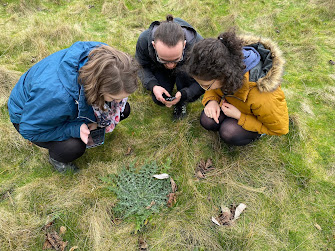Can species reintroductions be successful? The story of the lucky butterflies (part 1: Large Blues)
Large Blue history
The UK's population of Large Blue butterfly (Phengaris arion) has always been rare, and sadly declined until it went extinct in 1979. However, it's conservation and reintroduction has been a major success story in invertebrate conservation.
.JPG) |
| Large Blue butterflies mating at Daneway Banks (June 2023) |
 |
| BSBI and RES field meeting at Daneway (17th June 2023) |
The Large Blue relies on the red ant Myrmica sabuleti to complete its lifecycle. The decline of these ants in the 60s-70s resulted in the 1979 Large Blue UK extinction. These ants cannot build mounds to reach suitable microclimates (heat) unlike others such as the Yellow Meadow Ant. Therefore, the loss of grazing animals and land use change caused the grass to grow too long and the red ants to be outcompeted by another red ant (Myrmica scabrinodis).
The success of reintroduction came once the links between land management and ant populations was understood. Once ant populations were high enough, Large Blues from Europe were reintroduced in South West England in the 1980s and at Daneway Banks in 2010.
Ecology
The Large Blue is Fully Protected in the UK and critically, is the only UK insect species listed as Near Threatened on the global IUCN Red List of Threatened Species.
The Large Blue is the biggest species in the blue subfamily (Lycaenidae: Polyommatinae) and has distinctive large black spots on the forewings and thick and dark borders around the edges of the inner fore and hindwings. The undersides of the wings are pale brown with black spots. More information on how to identify the different life stages can be found on the UK Butterflies website.
Large Blue lifecycle
.jpg) |
| Large Blue egg and typical habitat at Daneway (June 2023) |
The caterpillar will fall to the ground where the foraging red ants will find it. The caterpillar mimics an ant larvae by adjusting its body shape and releasing ant-mimicking pheromones. The ant believes the caterpillar to be a lost ant larvae so returns the caterpillar to the nest and rears it as an ant. This is an example of social parasitism and without this vital stage of the Large Blue lifecycle, caterpillars wouldn't reach adulthood. The caterpillar spends 11-22 months in the ant nest (90% of its lifespan), feeding on ant larvae and then pupates to emerge as an adult the following summer. The adults primarily nectar on Selfheal (Prunella vulgaris), Wild Thyme, and Marjoram.
Management
Large Blue survival requires foodplants to be flowering at the correct time, as well as ant presence. The survival success depends on if there is suitable habitat available which meets all requirements with correct management. Daneway Banks is co-owned by RES and Gloucestershire Wildlife Trust, who manage the site.
During the flight period of Large Blues (end of June and beginning of July), the host plants, eggs, and larvae are vulnerable to trampling so visitors should remain on the designated paths. There is a roped off area on the hilltop to prevent trampling of breeding habitat.
 |
| Cordoned off area preserving breeding habitat at Daneway Banks (17th June 2023) |
Once Thyme and Marjoram have seeded and caterpillars are in their host nest, grazing management begins with hardy breeds of Welsh mountain ponies and Balwen sheep. These graze until spring to prevent swards getting too tall and reduce scrub encroachment allowing open areas for wildflowers to grow. If needed, volunteers also assist with removing scrub encroachment.
Due to the minimal dispersal distances of the Large Blue, it is vital to re-connect suitable sites across Gloucestershire and the Cotswolds' 'Golden Valley', such as Siccaridge Wood and Sapperton Valley. Project wardens are also on-hand during the flight season to inform visitors of how to safely observe the butterflies without disturbing their behaviour.
Daneway Banks SSSI
Daneway Banks is a large 42 acre reserve with a steep south-east facing slope covered by limestone grassland habitat (SSSI interest features). There are also some patches of scrub and trees including ancient Beech, Yew, Hawthorn and Hazel woodland.
 |
| Daneway Banks map and information board (June 2023) |
The habitats and success of the Daneway Banks site can be seen as a feature clip on the third episode of the 'Wild Isles' BBC documentary series narrated by David Attenborough. The habitat management at the site has also benefitted a whole host of invertebrates, vertebrates, and plant life including several species of interest regionally and nationally.
To mention a few would include (pictures from June of interesting species are below):
- Flora
- Up to 12 orchid species (Frog, Autumn Lady's Tresses, Fly, Musk, Green-winged, Greater Butterfly, and some more common species),
- Pasqueflower, Dwarf Rock-bristle, Angular Solomon’s-seal, Meadow Saffron, Hound’s-tongue, Dwarf Spurge, Sainfoin, Mountain Bedstraw, Autumn Gentian, Wild Liquorice
- National rarities: Cut-leaved Germander, Slender Bedstraw, Cut-leaved Selfheal
- Commoner but nice to see: Knapweed, Kidney Vetch, Harebell, Cowslips, Rock-rose
- Vertebrates
- Mammals: Hazel Dormouse, Roe Deer
- Amphibians and reptiles: Common Toad, Adder, Common Lizard, Grass Snake, and Slowworm
- Birds: Skylark, Yellowhammer, Song Thrush, Buzzard, Goshawk, and Bullfinch
- Invertebrates:
- Shrill Carder Bumblebee
- Rock-rose Pot Beetle, Rugged Oil Beetle, Hawthorn Jewel Beetle, Cryptocephalus aureoles, Glow-worm
- Dotted and Western Beefly, Downland Robber Fly, Downland Beefly, Inane Hoverfly
- Threatened butterfly species (Duke of Burgundy breeding since 2019, Small Blue, Adonis Blue, Brown Hairstreak, White-letter Hairstreak, Small Heath, Grizzled and Dingy Skippers, Marsh Fritillary) and others (Pearl-bordered, Dark Green, Silver-washed Fritillary, Brown Argus, Ringlet, Marbled White)
 |
| Insects and plants of interest seen at Daneway Banks (17th June 2023) |
References
Butterfly Conservation's project at Polden Hills involving the Large Blue
Case Study videos of Daneway Banks and Rodborough Common reintroductions:



Comments
Post a Comment